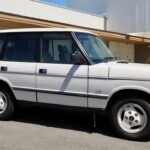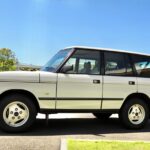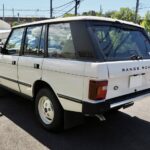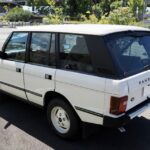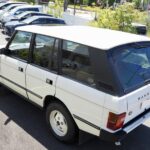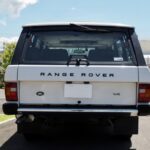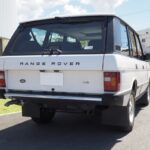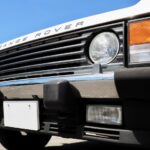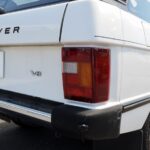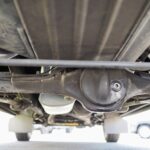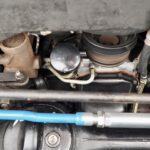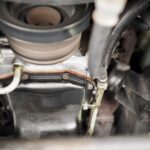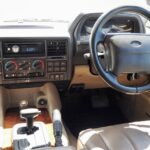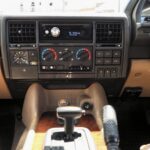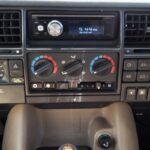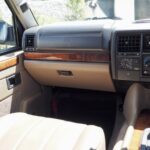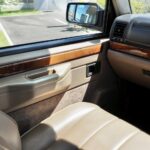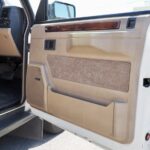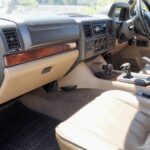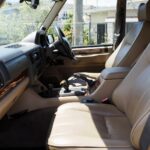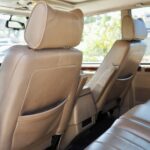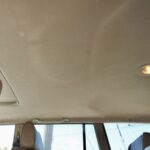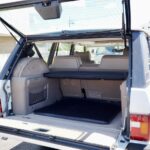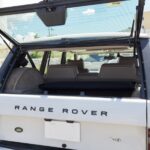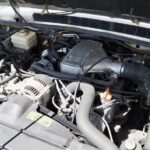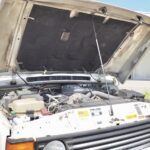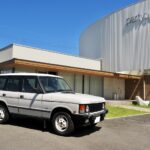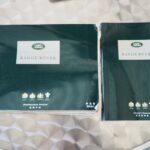TOP>Stock List>1994model Range Rover Classic 3.9L
1994model
Range Rover Classic 3.9L
↑↑↑Please watch the archived video above with audio if possible...
Astonishingly well-preserved in full original condition from the final era of the Range Rover Classic — this 1994 Range Rover Classic 3.9L, owned by the renowned “Sam’s Collection”, stuns with its rare Almond White finish gleaming brilliantly. A machine that allows one to truly feel the essence of mechanical beauty in its purest form.
Chapter One
A machine of pure essential beauty—one that cannot simply be found, but must be awaited as destiny reveals the encounter.
Every so often, when one encounters such a design on the street — its lines, its atmosphere, its aura — it delivers a jolt that reminds us how profoundly different these neo-classic cars are from anything built today.
Perfectly preserved in full original condition, they glide by with effortless grace — their understated presence so captivating that even a passing glimpse can steal one’s heart. Surely, this feeling is not mine alone.
Those who cherish such machines understand their essence. They care for them as one would a family member, treasuring them over decades — their very lifestyle reflecting this bond.
It is these cars, lovingly crafted during the 1980s and 1990s under the unwavering European philosophy of “building something truly good,” that we now call Neo-Classics or Youngtimers — the last generation of automobiles made with genuine pride and integrity.
Among this rare rise of neo-classics, few stand taller than the Range Rover Classic 3.9L, produced for only two short years between 1994 and 1995.
Born in the historic Solihull plant, it represents the origin of what we now call the “luxury SUV,” and at the same time, the final analog thoroughbred — mechanical, authentic, and pure.
Its heavy-duty suspension and ball-joint steering deliver an unmatched solidity; its full-time 4WD grants composure on any terrain; its vast luggage area provides true practicality.
Inside, the aroma of Connolly leather and the elegance of real Burr Walnut veneer evoke a level of craftsmanship that can no longer be reproduced today.
In its homeland, this aristocratic off-roader earned the enchanting title “The Rolls-Royce of the Desert.”
Cherished by the British gentry as their trusted companion for estate hunting, it remains a symbol of heritage, refinement, and authority — a presence that continues to captivate all who see or drive it.
“The single round headlights paired with that blacked-out, minimalist grille… it’s absolutely irresistible.”
The owner narrows his eyes fondly as he gazes at his beloved car.
This Range Rover Classic 3.9L belongs to “Sam’s Collection,” one of Japan’s most renowned private automobile collections.
The selection criteria for Sam’s Collection are not based merely on rarity or market value.
Rather, under the curator’s unwavering philosophy — “The most beautiful car is the one that remains as it was born” — only vehicles with pure provenance and authentic originality are carefully chosen.
Each acquisition undergoes expert-level restoration, with every imperfection meticulously addressed. These cars are preserved in the best possible mechanical and aesthetic condition, celebrated not only as machines but as works of historical art.
Today, Sam’s Collection stands among Japan’s most distinguished classic car ensembles, with multiple top awards in concours d’élégance competitions — each vehicle existing as an object of sensory appreciation.
Among the many vehicles the owner drives daily aside from his collection, this Range Rover Classic 3.9L holds a particularly dear place in his heart.
Having owned several classic Range Rovers over the years, he has long admired their innate dignity and mechanical honesty — qualities he deeply enjoys as part of his everyday motoring life.
He recalls that even low-mileage examples he once owned — with as little as 40,000 kilometers — were plagued by the characteristic suspension and drivetrain issues that haunt many classic Ranges.
Despite reluctantly parting with them, his affection for the single round headlamps and blacked-out grille never faded. He continued searching for an unspoiled example that captured that timeless functional beauty.
Then, about two years ago, fate intervened.
When he first laid eyes on this rare Almond White car — still in its original paint — he knew instantly: “This is destiny.” He purchased it on the spot.
Although the car was already remarkably original, he immediately entrusted it to Mr. Sawada, the master technician at British Motors Hyogo, a man he greatly respects for his exquisite work on the collection’s Aston Martins, to perform a full mechanical refresh.
It was Mr. Sawada who detected a faint differential noise that had gone unnoticed.
When asked, “Shall we address it?”, the owner’s response was immediate: “Fix everything. Leave nothing compromised.”
The result — a complete restoration of the drivetrain — eliminated every mechanical weakness. The cooling system was then refined for Japan’s climate, along with a total overhaul of the air-conditioning system, ensuring smooth performance and comfort even in the peak of summer heat.
Now, as the owner looks lovingly at his Range Rover and says, “I’ve never driven a Classic Range that feels this seamless,” the statement is no exaggeration.
He occasionally takes it out from his garage — simply to drive and enjoy — and every outing reaffirms the exquisite sensory pleasure it delivers.
Naturally, it remains entirely trouble-free to this day.
Still wearing its original paint after more than thirty years, the Almond White finish glows with authentic luster, unmarred by rust or corrosion — never once repainted.
Even beneath the car, one finds evidence of meticulous care, with a spotless underbody. Through the clear, untinted windows, the tan Connolly leather interior radiates warmth, every stitch and piping preserved beautifully.
The fragrance of aged leather fills the cabin, while the Burr Walnut wood trim — now an extinct art form — harmonizes perfectly with the interior, creating a sanctuary of refinement that can only be described as pure automotive therapy.
Indeed —
The essential beauty of this 1994 Range Rover Classic 3.9L transcends time.
Even after three decades, and for decades yet to come, its quiet dignity will continue to deepen — whispering to those who understand what true presence really means.
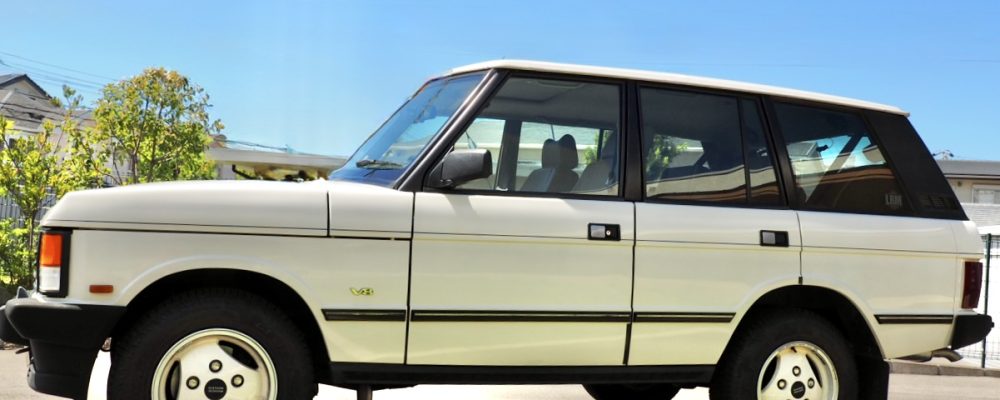
Chapter II
The Lineage of Range Rover Tradition and the Ultimate Destination — “The Final Classic”
The Mini — its wheels pushed boldly out to each corner, embodying the essence of a go-kart — is a car that never fails to delight. No matter the model year or specification, whether in stock form or tastefully customized, few cars make the basic acts of driving, braking, and steering feel so purely joyful.
It’s little wonder that many seasoned enthusiasts, after owning numerous sports and GT cars, choose this simple yet profoundly engaging machine as their “final car in life.”
Codenamed ADO15, the Mini was born in 1959 under the names Austin Seven and Morris Mini Minor. Over nearly half a century, it captured the hearts of enthusiasts worldwide, with an astounding 5,387,862 units produced before the end of its run in 2000 — a true masterpiece by its creator, Sir Alec Issigonis.
In postwar Britain of the late 1950s, as the nation began to recover and prosperity beckoned, the Suez Crisis struck — triggering the first oil shock. Rising fuel prices and shrinking demand for large-displacement cars sparked a new need: “a smaller, smarter car.”
Issigonis, then an engineer at BMC (British Motor Corporation), responded with radical thinking. He designed a compact body just 10 feet long (about 3 meters) that could comfortably seat four adults. His genius lay in the transverse-mounted engine with front-wheel drive, the world’s first of its kind.
By integrating the gearbox beneath the engine and pushing the wheels to the very corners, he achieved both an astonishingly spacious cabin and exceptionally nimble handling. Thus, in 1959, two small cars that would change the world were born: the Austin Seven and the Morris Mini Minor.
Though tiny, the Mini had a huge presence. It quickly captured the hearts of the British public — from royalty to students, from the working class to celebrities — a true social phenomenon.
But it was John Cooper, the race-car constructor, who turned this clever small car into a legend.
Recognizing its superb handling, Cooper developed the Mini Cooper in 1961. Despite its modest sub-1000cc engine, it dominated the rally world. The legendary duel with Porsche at the Monte Carlo Rally’s Col de Turini became a symbol of the “giant killer” — a small car overtaking mighty sports machines in the snow — earning the Mini everlasting glory as “the small giant.”
By late 1967, riding on the immense success of the first-generation Mk-I (1959–1967), the Mk-II was born. More than a facelift, it represented the mature, perfected form of the Mini.
Visually, the Mk-II received a redesigned rear panel and larger square tail lamps to meet new safety standards, with the license plate moved lower.
A new horizontal-slat grille lent a modern appearance, the oval bonnet badge proudly spelled out “Morris Cooper,” and a rain channel around the windshield improved weather protection. Structurally, the body was reinforced, subframe mounts stiffened, heater performance enhanced, and switch layout improved — even the trunk space grew slightly.
Yet the core philosophy of size and lightness, sacred to Issigonis, remained untouched.
With its sub-600kg body and the sharp, high-compression 998cc engine, the Mk-II delivered electrifying response — this was its essence.
The 998cc “9F-TA-H” engine in the Morris Mini Cooper Mk-II 1000 was an exclusive high-tune unit, featuring twin SU carburetors and a cross-flow head producing a then-remarkable 55 horsepower.
In a 10-foot body, it drove like a pure racing kart — a thrilling, “horse-and-rider-as-one” experience that reignited passion among enthusiasts.
Another charming detail lay in the subtle differences between Morris and Austin variants:
the Morris Cooper employed more refined chrome accents and a classically British aura, while the Austin Cooper leaned toward a sportier image.
Thus, examples bearing the Morris nameplate — like the one introduced here — embody the most authentic and elegant expression of British motoring design.
By 1968, the Mk-II Cooper reached its final chapter. In 1969, the Cooper badge disappeared temporarily, leaving only the Cooper S in production.
This makes the Mk-II Cooper 1000 the last true Cooper born under the BMC banner — the final chapter of the original Mini Cooper story.
Many Minis were modified or carelessly treated over the decades, and fully original examples are now exceedingly rare — even in the UK.
That is why the specimen with Chassis #KA2S6-1220538A / Commission #250S-10577A / Engine #9F-TA-H987 stands as a genuine survivor — an irrefutable testament to what a true Morris Mini Cooper Mk-II 1000 really is.
Would you like me to format this as a magazine editorial feature (with subheadings, emphasis, and flow like a printed article), or keep it in classic listing style (clean paragraphs for catalog or website use)?

Chapter III
Postscript — Reflections on the 1994 Final Range Rover Classic 3.9L
It was truly a car that stirred my soul.
The 1994–1995 final-series Range Rover Classic models—now celebrated as the “epilogue chapters” of the lineage—have, as you know, been elevated into the realm of collectable icons. The distinctiveness of this special model year and its ultimate specification clearly define its enduring value.
The fundamentals remain pure: a ladder frame, coil springs, and full-time four-wheel drive—the essential architecture of Range Rover engineering.
Layered atop these mechanical foundations is just the right measure of electronic refinement—ABS, ETC, and other systems that enhance control without overwhelming it.
Neither excessively digitized nor primitively analog, the final Range Rover Classic represents the perfect synthesis of man, machine, and reason.
The natural steering response, the honest brake feel, and the fatigue-free comfort of its magnificent seats over long distances all speak not to technical specifications—but to the conscience of sound engineering.
And then, of course, there is the design—the very element that continues to captivate its devoted owner.
The symmetry of the round single headlamps and black grille, the disciplined geometry of its straight-lined bodywork—these give it an undeniable presence in any era.
Step inside, and you are enveloped by the deep texture of Connolly leather, the warmth of burled walnut veneer, and the calm, luxurious scent that fills the cabin—an atmosphere that engages every sense in quiet harmony.
This sensory allure—stimulating the right side of the brain—is irresistible to true neo-classic enthusiasts.
In the Range Rover Classic, decoration is never the main act; form follows function, and beauty is born as the natural result.
It is precisely this unbroken adherence to order that allows the car to embody a pure aesthetic truth—an authentic beauty that lives and breathes through its mechanical honesty.
Why, then, is the “final Range Rover Classic” so revered?
One only has to gaze upon this example to understand.
It is the last true analog luxury SUV—a singular blend of strength and sophistication that the world will never see again.
Collectors across the globe continue to seek out pristine, original examples like this one—cars that combine the rugged structure of an off-roader with the composure of a grand tourer, subtly guided by just enough electronic intelligence.
This balance—between brawn and refinement, past and future—is a privilege reserved only for the carefully crafted final-series models of 1994–1995.
Moreover, their historical status as the “closing chapter” ensures their place as true collector’s treasures.
The 1994 Range Rover Classic 3.9L from the renowned Sam’s Collection is one such masterpiece—an example that strikes directly at the heart of what makes the Classic immortal.
To stand before this fully original car, preserved in its purest form, was to feel a profound resonance.
It was, without exaggeration, a moment that moved me to my core.

An astonishing survivor that preserves the full originality of the final-generation Range Rover Classic— this 1994 Range Rover Classic 3.9L, finished in the rare and radiant Almond White, owned by Sam’s Collection, is a machine through which one can sensually experience the essence of true beauty itself.
A car so rare it cannot be sought—only awaited.
A machine through which one can savor the pure essence of automotive beauty.
We warmly invite you to visit and experience this captivating masterpiece in person—
an encounter sure to stir your heart and soul.
As this is a private-party transaction, there will be no consumption tax or additional dealer fees.
Upon purchase, the buyer will be responsible for the pro-rated portion of the annual automobile tax (¥76,400) and the automobile recycling deposit fee.
Transportation or delivery arrangements are also to be made by the buyer; however, my company offers classic car transport services using our own carrier truck, and we would be pleased to assist upon request.
Inquiries
This vehicle is featured on the cross-border classic and collectible car marketplace “Estate Sale Supremacy®.”
What is Estate Sale Supremacy®?
It is the Japanese interpretation of the North American “estate sale” culture—an elevated, dignified means of passing on cherished automobiles.
Each vehicle listed is introduced through a carefully crafted editorial and video interview, faithfully expressing the owner’s emotions and history with the car, ensuring those memories live on while the vehicle transitions seamlessly to its next custodian.
We conduct detailed interviews with the current owner, including the vehicle’s maintenance and repair history, accident record, and ownership background.
If a major accident is confirmed or the owner’s tenure is too short to verify the details, we decline to feature the vehicle, prioritizing transparency and buyer confidence.
About This Article
This feature was written based on a three-hour interview and passenger test ride with the owner conducted on September 1, 2025, beginning at 10:00 a.m. under clear skies.
Please note that, due to the limited time available, some details of the vehicle’s condition may not be fully or perfectly represented.
Descriptions and comments reflect the writer’s personal impressions and the observed condition at the time of the interview, and are not guaranteed through independent verification.
Vehicle Viewing and Inquiries
For questions or to request an in-person inspection, please contact us via the link at the bottom of this page.
As this is a private-party transaction, viewings are limited to prospective buyers who are seriously considering a purchase.
Thank you very much for your kind consideration.











